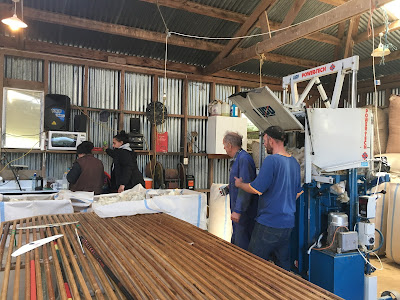When I arrived to my first WWOOF destination,
John and Shona Chapman's near Port Chalmers, I dived right in. This was despite the exhausting trip I just finished as sheep shearing was in full action. Immediately I was tested by being
asked to grab a loose sheep, they actually aren't easy to catch. They can be a bit sheepish, ok sorry, couldn't help myself. "Oh you have to grab the feet?" I told John. I worked for a few
hours helping loading and compact the fur coming off the sheep to form shippable
bails. This is what's referred to as pressing in the industry, one of many sheep, farm, and Kiwi specific vocab. that I would come to learn in the near future like "French the skinnies." Pressers can earn as much as $20/hour, not too bad for a pretty low skilled job, but it is tiring. I spent my next full day pressing and hung out with the visiting contracted shearing "team" including 3 lady wool sorters/cleaners and 3 dude shearers (basically giving sheep buzz cuts with razors, but much harder than you might guess). There's real skill and technique involved in that trade.
Sheep are such nervous and awkward (they are constantly running into and onto each other when you get them in tight spaces) creatures. They are so harmless it's almost comical watching them get sheared but no one has any time to laugh, it's an assembly line basically and numbers game for how much the shearers get paid. The shearers are fed a constant stream of sheep that then get kind of pushed down a shoot before they pull the next struggling and fighting sheep over. My biggest surprise was how oily sheep are and how it gets all over your hands dealing with them. The “shed” as they call the place where your shear here, is a noisy place with the loud music and pressing machine running. I found it really hard to understand directions, especially with the Kiwi accent. I probably got about as much out of most conversations as I do when I’m speaking French really.
Bob and Shona have built an impressive operation at their farm, passed down from Bob's farther, and soon to be passed on to their son Robert (33) who recently joined the team. The system of different holding cells (what they call paddocks, or fields) and gates with their herder dogs make it fairly easy to control the sheep within their vast property. Once you push them in a direction they really do all follow. But what seems simple with sheep quickly becomes incredibly complicated. Timing the shearing with lambing, pregnancy screening, and subsequent wool collection times (there's 4 throughout the year) is tricky and actually can affect the length and quality of wool you get substantially. The speed at which the wool of a sheep grows actually varies substantially according to season. The pregnancy rates can also vary a lot season to season (Bob said his sheep get a C+ this season; I guess they didn't like the rams that much) - more on the screening process in my next post.
My experience with sheep here has been eye opening and a worthwhile experience. I mean I figured there was a strategy to sheep, like everything, but I didn’t realize everything that's involved with this job dating back to the bible. You hear about farming being back breaking labor and how it's become so much harder to be profitable these days but understanding why and somewhat experiencing it is a different thing.
Besides shearing, pregnancy testing, dipping (to prevent lice which is now a spray and no longer involves actually dipping sheep), disinfecting (spraying iodine), all of which I performed or participated in, there's also drenching (external parasite control), dosing (internal parasite control), lambing (when they give birth obviously but also introducing the rams), tailing (cutting off their tails for hygienic reasons), abortion injections, and weaning, which precedes selling the sheep, and all these activities are beyond the regular every day activities. You have to strategize around where and when you will move sheep (which is very seasonally dependent) and constantly move them to graze (great distances if the flock is large) as well as construct temporary electric fences, grow food (in the winter with grass being sparser they grow turnips and other crops for the sheep), weigh them, separate different groups (weak, strong, old, young, pregnant, etc.), negotiate prices, fill out paperwork, buy equipment and fertilizer, contact brokers, control the weeds, refill water troughs, and perform other regular farm maintenance. Finally, in John's case, he has to apply all of the above to each of his 2000 sheep, all while operating on an incredibly hilly landscape with in-contiguous parcels and other animals like cows that he has to worry about. Hard to take a vacation I think.
More Photos to come...







No comments:
Post a Comment